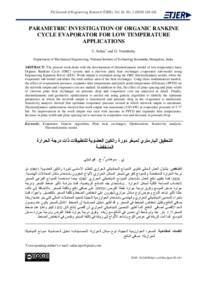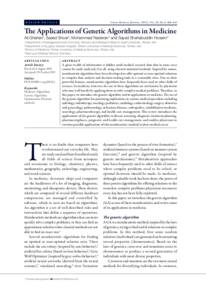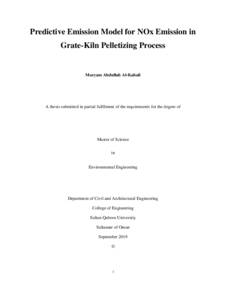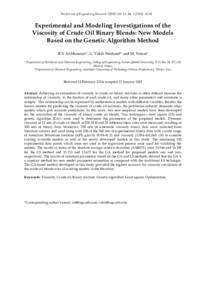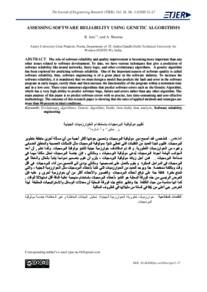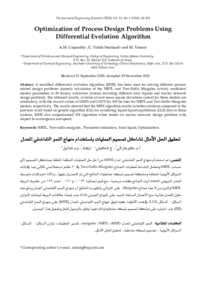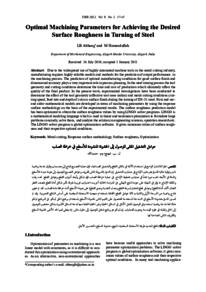وثيقة
Parametric investigation of Organic Rankine Cycle evaporator for low temperature applications.
المساهمون
Veershetty, G., مؤلف
الناشر
Sultan Qaboos University.
ميلادي
2019
اللغة
الأنجليزية
الموضوع
الملخص الإنجليزي
The present work deals with the development of thermodynamic model of low temperature basic Organic Rankine Cycle (ORC) system and a chevron plate heat exchanger evaporator sub-model using Engineering Equation Solver (EES). Work output is evaluated using the ORC thermodynamic model, while the evaporator sub-model calculates the total surface area of the heat exchanger. Using these mathematical models, the effect of evaporation pressure, expander inlet temperature and pinch point temperature difference (PPTD) on the network output and evaporator cost are studied. In addition to this, the effect of plate spacing and plate width of chevron plate heat exchanger on pressure drop and evaporator cost are analyzed in detail. Finally, thermodynamic and geometric optimization is carried out using genetic algorithm to identify the optimum parameters at which the network output is maximized and pressure drop in the evaporator is minimized. Sensitivity analysis showed that optimum evaporator pressure existed at which network output is maximum. Thermodynamic optimization showed that work output was maximum (5.03 kW) at evaporator pressure of 5.77 bar. No improvement in the work output was seen with increase in PPTD and expander inlet temperature. Increase in plate width and plate spacing led to increase in evaporator cost and decrease in pressure drop.
السلسلة
;https://www.shuaa.om/xmlui/bitstream/item/d0046c4c-88fa-445a-b22c-2ea804ab8f0f/Parametric%20investigation%20of%20Organic%20Rankine%20Cycle%20evaporator%20for%20low%20temperature%20applications..pdf?sequence=1&isAllowed=y
المجموعة
ISSN
1726-6742
URL المصدر
zcustom_txt_2
Suhas, U., & Veershetty, G. (2019). Parametric investigation of Organic Rankine Cycle evaporator for low temperature applications. The Journal of Engineering Research, 16 (2), 130-141.
الملخص العربي
يتناول العمل الحالي تطوير النموذج الديناميكي الحراري للنظام الأساسي لدورة رانكين العضوية (ORC) ذو درجة الحرارة المنخفضة والنموذج الفرعي لمبخر المبادل الحراري لألواح شيفرون باستخدام محلل المعادلات الهندسية. (EES) قمنا بتقييم ناتج العمل باستخدام النموذج الديناميكي الحراري ORC، بينما استخدمنا النموذج الفرعي للمبخر لاحتساب المساحة الكلية لمبادل الحرارة. وباستخدام هذه النماذج الرياضية، قمنا بدراسة تأثير ضغط التبخر ودرجة حرارة مدخل الموسع وفرق درجة حرارة نقطة القرص (PPTD) على صافي ناتج وتكلفة المبخر. بالإضافة إلى ذلك، حللنا تأثير تباعد اللوح وعرض لوح مبادل حراري شيفرون على انخفاض الضغط وتكلفة المبخر بالتفصيل. وأخيرًا، قمنا بإجراء التحسين الديناميكي الحراري والهندسي باستخدام الخوارزمية الجينية لتحديد المعاملات المثلى التي يتم عندها زيادة صافي الناتج وتقليل انخفاض الضغط في المبخر. وقد أظهر تحليل الحساسية أن الضغط الأمثل للمبخر يكون عند وصول الحد الأقصى لصافي الناتج. كما أظهر التحسين الديناميكي الحراري أن أقصى إنتاج كان (5.03 كيلو واط) عند ضغط المبخر 5.77 بار. هذا ولم يلحظ أي تحسن في الناتج مع زيادة وفرق درجة حرارة نقطة القرص ودرجة حرارة مدخل الموسع. كما أدت الزيادة في عرض اللوح وتباعد الألواح إلى زيادة في تكلفة المبخر ونقص في انخفاض الضغط.
قالب العنصر
مقالات الدوريات

